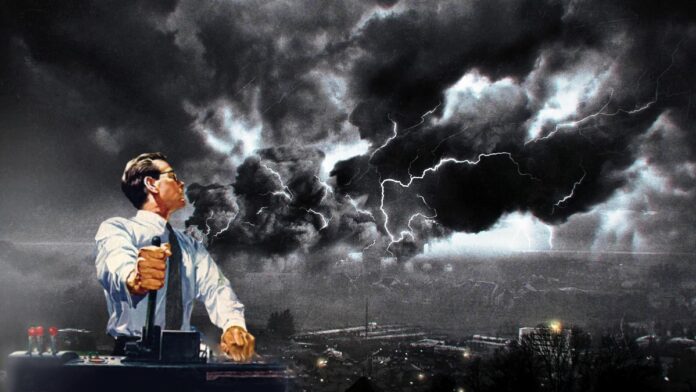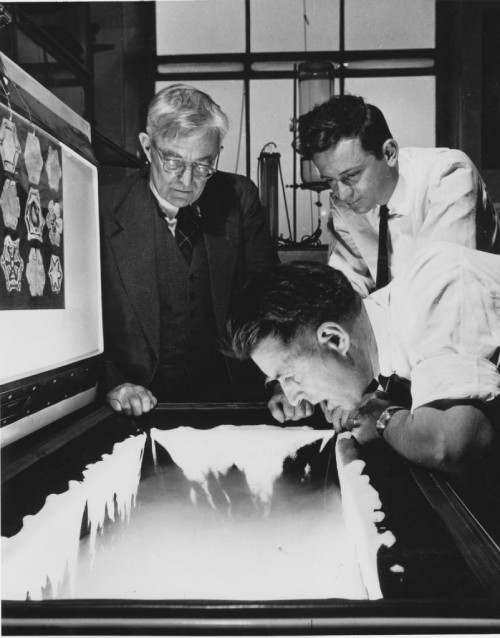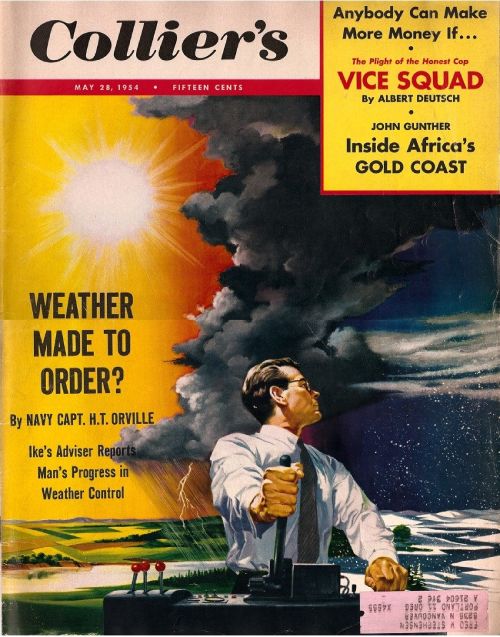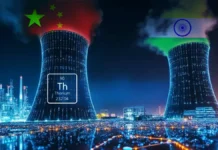
As the world becomes aware of the environment’s brittleness, more diversified and complex ways have been devised to modify it as a weapon of Warfare. Now a new class of firearms more disastrous than nuclear Warfare is on the horizon. For altering the environment, weather and climate modification technologies are the methods that may be used to convert climate and weather systems into weapons of war. It refers to Operation Popeye, which aimed to extend the monsoon season in Southeast Asia.
Captain Orville had cautioned that “if an enemy nation solves the problem of weather control and gets into the position of controlling large-scale weather patterns before we can, the effects might be even more devastating than nuclear conflict.” In this article, we have discussed in-depth Weather Modification Technology in Warfare and how this method of modern Warfare can be used to destroy any country economically, Tactically, Strategically, and Covertly.
Contents
What is Weather Warfare?
Weather warfare is a method of Warfare in modern Warfare that uses weather modification and geoengineering techniques to purposefully alter the weather so that this changing weather can be used in such a way that the enemy nation can be defeated economically, strategically, and covertly, and inflict as much damage as possible. The enemy could not fight the war in this situation due to bad weather. The most common weather warfare technique is cloud seeding, which can increase rain or snow. Weather modification can be used in Warfare because it serves as a tactical weapon, a strategic weapon, or a covert way of weakening the well-being of an enemy state.
Military Weather Modification Technology and weather control programs are similar in many ways. For example, techniques for removing warm and super-cooled fog, changing cloud cover, increasing precipitation (rain or snow), manipulating lightning, and dealing with hurricanes and other severe storms, have all received attention. Likewise, the impact of injecting pollutants into the atmosphere, spreading lampblack on ice, releasing frozen carbon dioxide into the clouds to make snowstorms, and depleting ozone, Experiments and calculations have been done with all.
Tactically, it can be used as follows:
- As an immediate weapon
- In aid of an assault
- In conjunction with other weapons
- For the broad battle defense of one’s forces and infrastructure.
Strategically it can be used to strike an enemy at the source of his military. This will make enemies economically and politically weak.
Covertly it can damage the enemy’s ecosystem, destroy agriculture, and disable communications networks.
Experiments to test Weather Modification
In 1924, Prof. Emory Leon Chaffee of Harvard University dispensed charged sand from an airplane to attempt to modify weather. W. Veraart, in 1930, dropped dry ice into clouds to modify weather. Unfortunately, his technique and results were published only in his book, which was in Dutch. Prof. Henry G. Houghton of MIT sprayed hygroscopic solutions into the fog in 1938 to dissipate the moisture.
On November 13, 1946, Curtis Talbot, a pilot working in the General Electric Research Laboratory, and Dr. Vincent J. Schaefer, a scientist, flew to a height of 14,000 feet approximately 30 miles east of Schenectady, New York. To experiment with the weather control, they threw three pounds of dry ice (frozen carbon dioxide) into the clouds and were shocked by the results.
As they turned towards the south, Dr. Schaefer noticed and said, “I looked toward the rear and was thrilled to see long streamers of snow falling from the base of the cloud through which we had just passed. I shouted to Curt to swing around, and as we did so, we passed through a mass of glistening snow crystals! We were quite excited”. So they’d manufactured artificial snowfall, or you can say snowstorm.
Following General Electric Research Laboratory’s experiments, there was a feeling that humanity could finally regulate and modify weather for Warfare. As tensions between the US and the Soviet Union grew, weather control was regarded as a potential weapon that may be even more destructive than nuclear weapons.
History of Weather Warfare
In August 1953, the President’s Advisory Committee on Weather Control was established in the US. Its goal was to assess the efficacy of weather modification methods and the extent to which the government should participate in them—using colored pigments on the polar ice caps to melt them and unleash devastating floods, releasing large amounts of dust into the stratosphere to create precipitation on demand. In addition, it refers to Operation Popeye, which aimed to extend the monsoon season in Southeast Asia.
A dam project was also designed by a Russian engineer named Arkady Borisovich Markin across the Bering Straits(The Bering Strait is a strait between the Pacific and Arctic oceans, separating the Chukchi Peninsula of the Russian Far East from the Seward Peninsula of Alaska, US) fitted with thousands of nuclear-powered pumps, which would divert Pacific Ocean waters, raising temperatures in places like New York and London in theory. Although Markin’s declared goal was to “relieve the extreme cold of the northern hemisphere,” American experts were concerned that weather control might be used to create flooding. In the mid-1950s, all the methods conceived by both American and Soviet scientists were openly discussed in the media.
Operation Popeye was a classified US military operation from 1967 until 1972. The goal was to extend the Monsoon season in Southeast Asia. The torrential rain successfully hampered the Vietnamese army’s tactical logistics. The first practical use of weather manipulation technology in combat is said to have occurred during Operation Popeye. However, the Environmental Manipulation Convention(ENMOD) prohibited weather modification in action when it was revealed.
Air Force Major Barry B. Coble briefly chronicles the existence of weather modification technology in “Benign Weather Modification,” released in March 1997, where he traces the advancements that have happened, most notably in the hands of the Pentagon and CIA’s staunchest ideological adversaries. You can read this paper here – Benign Weather Modification PDF.
In 1948, the meteorological community acknowledged the first scientifically managed and monitored endeavor as constituting weather manipulation. Dr. Irving Langmuir’s initial experiments with intentionally seeding clouds to generate rain yielded promising results, creating great interest in the area almost instantly.
In the 1990s, US Air Force Chief of Staff Ronald R. Fogleman issued an order to evaluate the ideas, capabilities, and technology the United States would need to be the dominant air and space force in the future.
A 1996 research report published for the United States Air Force speculates on the future use of nanotechnology to create “artificial weather,” clouds of microscopic computer particles all interacting to generate an “intelligent fog” that might be utilized for a variety of reasons. However, as they progress, the importance of their potential applications will continue to increase. For example, an Air Force officer cadet in an unclassified academic paper produced by students defines weather modification technology as a force multiplier with revolutionary potential that can be used in a full range of post-war situations.
Weather Modification Technology that could be used in Weather Warfare
Many countries worldwide still have many drills and experiments to know how to manipulate the weather and use it in Warfare; for example, the Russians have long been involved in weather modification to control hail. China has also been using cloud seeding to bring rain.
According to conspiracy theorists, weather modification, geoengineering, chemtrail, High-frequency Active Auroral Research Program – HAARP and other ideas are not scientific infrastructures or research but modern military weapons that could be used in Weather Warfare to strike down the enemy.
Weather Control can be as effective as the atomic bomb in Warfare.
According to Dr. Irving Langmuir, a Nobel Prize-winning physicist and a pioneer in rainmaking, who had worked with Dr. Vincent J. Schaefer during those early experiments conducted for the General Electric Research Laboratory, “Rainmaking or weather control can be as effective as the atomic bomb in warfare.” Langmuir remarked that the effect of 30 milligrams of silver iodide under ideal conditions equals that of one atomic bomb in terms of energy liberated.
Langmuir further said that “the government should grab the phenomena of weather control in the same way it did atomic energy when Albert Einstein warned the late President Roosevelt in 1939 of the potential power of an atom-splitting weapon”. Langmuir’s quotes on weather control were published in a short article in the Charleston Daily Mail on December 11, 1950.
According to Captain Howard T. Orville, chairman of the 1953’s President’s Advisory Committee on Weather Control, the US, “A weather station in southeast Texas spots a threatening cloud formation moving toward Waco on its radar screen; the shape of the cloud indicates a tornado may be building up. An urgent warning is sent to Weather Control Headquarters. Back comes an order for aircraft to dissipate the cloud. And less than an hour after the incipient tornado was first sighted, the aircraft radios back: Mission accomplished. The storm was broken up; there was no loss of life or property damage. This hypothetical destruction of a tornado in its infancy may sound fantastic today, but it could well become a reality within 40 years. In this age of the H-bomb and supersonic flight, science may find ways to dissipate incipient tornadoes and hurricanes and influence all our weather to the degree that staggers the imagination. Indeed, if the investigation of weather control receives public support and funds for research its importance merits, we may eventually be able to make weather almost to order”.
On the cover of Collier’s magazine, a guy was seen changing the seasons with levers and push-buttons. As the piece highlighted, in an era of atomic bombs and supersonic flying, anything appeared conceivable in the latter part of the twentieth century. Captain Orville was the author of the cover article, May 28, 1954.
Conclusion
Purposefully altering the weather and using it for Warfare is inhumane. Still, suppose an unfriendly nation solves the problem of weather control and is in a position to control large-scale weather patterns. In that case, The consequences could be more disastrous than nuclear war, as Captain Orville puts it. Hence, it is apparent that countries worldwide would experiment to master weather warfare. Unfortunately, according to many conspiracy theorists, the US has got it, due to which Russia and China also do not want to lag.
From our point of view, the weather is a natural system that naturally forms and changes due to the earth’s and moon’s rotation. However, changes in the ocean due to the sun and any human modification can bring terrible results. In many ways, this can destroy the enemy country so that that country can never emerge again. Therefore, weather warfare is a very destructive warfare system that governments worldwide should consider together and take appropriate steps for its regulation.
Sources
- World Meteorological Organization. “‘Present State of Knowledge and Possible Practical Benefits in Some Fields of Weather Modification.
- National Academy of Sciences. 1973. Weather and Climate Modification Washington, DC
- Smith, J. E. (2006). Weather warfare. Adventures Unlimited Press.
- James E. McDonald, “A Historical Note on an Early Cloud-Modification Experiment,” Bulletin of the American Meteorological Society, Vol. 42, p. 195, March 1961.
- Horace R. Byers, “History of Weather Modification,” pp. 3-44, in W.N. Hess, editor, Weather, and Climate Modification, Wiley-Interscience, 1974.
- Standler, R. B. (2003, January 21). History and Problems in Weather Modification. Ronald B. Standler. Retrieved July 18, 2021, from http://www.rbs2.com/w2.htm
- GE. (n.d.). Cool Science: How Kurt Vonnegut’s Brother Tried To Break Up Hurricanes | GE News. Retrieved July 18, 2021, from https://www.ge.com/news/reports/cool-science-vonnegut-ge-research
- K. (2019, February 13). The Plan to Dam the Bering Strait. Daily Kos. Retrieved July 19, 2021, from https://www.dailykos.com/stories/2019/2/13/1834614/-The-Plan-to-Melt-the-Ice-Caps
- http://rednet.solutions. “Operation Popeye, Motorpool, Intermediary, Compatriot: Weather Warfare Over Vietnam · Weather Modification History.” weathermodificationhistory.com.
- Barry B. Coble (1997). Benign Weather Modification (PDF). Air University Press.
- “United Nations Treaty Collection.” treaties.un.org.
- Langmuir, Irving (December 13, 1948). Final Report: Project Cirrus (Report No. PL 140 ed.). General Electric Research Laboratory. p. 14.
- Vostruxov, Ye (September 1987). Laser and Cloud: Unusual Experiment of Siberian Scientists. Translated by SCITRAN, Wright-Patterson AFB, Ohio, Foreign Technology Division. p. 5.
- House, Tamzy J.; et al. “Weather as a Force Multiplier: Owning the Weather in 2025” (PDF). US Air Force.
FACT CHECK: We strive for accuracy and fairness. But if you see something that doesn’t look right, please Contact us.
DISCLOSURE: This Article may contain affiliate links and Sponsored ads, to know more please read our Privacy Policy.
Stay Updated: Follow our WhatsApp Channel and Telegram Channel.














I think that aliens are controling these crazy scientists for the purpose of terraforming the planet for their own purposes
Chemtrails with all their toxic contents became reality on a daily basis in 1997.
Ziggy Brzezinski in his Between Two Ages book said weather control was in the making.
And don’t doubt that this same technology is ALSO used by governments against their own people…especially in the US.